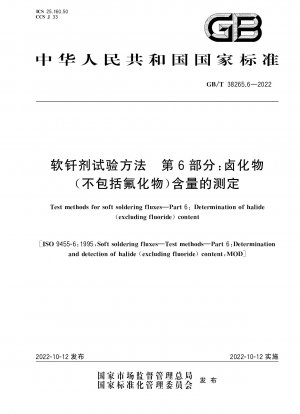GB/T 38265.6-2022
Test methods for soft soldering fluxes—Part 6: Determination of halide(excluding fluoride)content (English Version)
- Standard No.
- GB/T 38265.6-2022
- Language
- Chinese, Available in English version
- Release Date
- 2022
- Published By
- General Administration of Quality Supervision, Inspection and Quarantine of the People‘s Republic of China
- Latest
- GB/T 38265.6-2022
- Scope
- This document specifies three quantitative determination methods for the content of ionic halides in solder and a qualitative analysis method for ionic halides, including principles, reagents, equipment, test procedures, test data processing, expression of test results, and precision. degrees, test reports, etc. Method A in this document is applicable to Type 1 and Type 2 solder fluxes defined in GB/T 15829, and is used as a reference method for solder fluxes with a halide content of 0.05% to 2% (mass fraction) in non-volatile substances. Method B in this document is applicable to the determination of the total content of halides (excluding fluorides) in type 212 and type 311 solder defined in GB/T15829. Method C in this document is applicable to type 321 water-soluble solder containing phosphate as defined in GB/T 15829. Method D in this document is applicable to the qualitative analysis of ionic halides in all types of solders.
GB/T 38265.6-2022 Referenced Document
- GB/T 11415 Laboratory sintered(fritted) filters--Porosity grading, classification and designation
- GB/T 38265.1 Test methods for soft soldering fluxes—Part 1:Determination of non-volatile matter—Gravimetric method
- GB/T 38265.2 Test methods for soft soldering fluxes—Part 2: Determination of non-volatile matter—Ebulliometric method
- GB/T 626 Chemical reagent Nitric acid
- GB/T 6379.2 Accuracy(trueness and precision)of measurement methods and results-Part 2:Basic method for the determination of repeatability and reproducibility of a standard measurement method
- GB/T 686 chemical reagent acetone*, 2023-08-06 Update
- GB/T 9335 Nitrobenzene
- GB/T 9854 Chemical reagent.Oxalic acid dihydrate
- HG/T 2892 Chemical reagent isopropyl alcohol
GB/T 38265.6-2022 history
- 2022 GB/T 38265.6-2022 Test methods for soft soldering fluxes—Part 6: Determination of halide(excluding fluoride)content

GB/T 38265.6-2022 -All Parts
GB/T 38265.1-2019 Test methods for soft soldering fluxes—Part 1:Determination of non-volatile matter—Gravimetric method
GB/T 38265.10-2019 Test methods for soft soldering fluxes—Part 10:Flux efficacy test—Solder spread method
GB/T 38265.11-2021 Test methods for soft soldering fluxes—Part 11: Solubility of flux residues
GB/T 38265.13-2021 Test methods for soft soldering fluxes—Part 13: Determination of flux spattering
GB/T 38265.14-2021 Test methods for soft soldering fluxes—Part 14: Assessment of tackiness of flux residues
GB/T 38265.15-2021 Test methods for soft soldering fluxes—Part 15: Copper corrosion test
GB/T 38265.16-2019 Test methods for soft soldering fluxes—Part 16:Flux efficacy test—Wetting balance method
GB/T 38265.17-2022 Test methods for soft soldering fluxes—Part 17: Surface insulation resistance comb test and electrochemical migration test of flux residues
GB/T 38265.2-2019 Test methods for soft soldering fluxes—Part 2: Determination of non-volatile matter—Ebulliometric method
GB/T 38265.3-2022 Test methods for soft soldering fluxes—Part 3:Determination of acid value—Potentiometric and visual titration methods
GB/T 38265.5-2021 Test methods for soft soldering fluxes—Part 5: Copper mirror test
GB/T 38265.6-2022 Test methods for soft soldering fluxes—Part 6: Determination of halide(excluding fluoride)content
GB/T 38265.8-2022 Test methods for soft soldering fluxes—Part 8: Determination of zinc content
GB/T 38265.9-2022 Test methods for soft soldering fluxes—Part 9: Determination of ammonia content